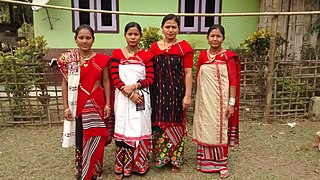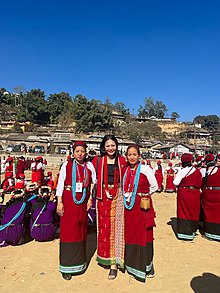Lhoba is any of a diverse amalgamation of Sino-Tibetan-speaking tribespeople living in and around Pemako, a region in southeastern Tibet including Mainling, Medog and Zayü counties of Nyingchi and Lhünzê County of Shannan, Tibet.

Arunachal Pradesh is a state in northeast India. It was formed from the North-East Frontier Agency (NEFA) region, and India declared it as a state on 20 February 1987. Itanagar is its capital and largest town. It borders the Indian states of Assam and Nagaland to the south. It shares international borders with Bhutan in the west, Myanmar in the east, and a disputed 1,129 km border with China's Tibet Autonomous Region in the north at the McMahon Line. Arunachal Pradesh is claimed by China as part of the Tibet Autonomous Region; China occupied some regions of Arunachal Pradesh in 1962 but later withdrew its forces.

Nyishi community is the largest ethnic group in Arunachal Pradesh in north-eastern India. The Nyishi language belongs to the Sino-Tibetan family, however, the origin is disputed. Their population of around 300,000 makes them the most populous tribe of Arunachal Pradesh, closely followed by the tribes of the Adi according to 2001 census.
The Indian state of Arunachal Pradesh has a total population of roughly 1.4 million on an area of 84,000 km2, amounting to a population density of about 17 pop./km2. The "indigenous groups" account for about two thirds of population, while immigrants, mostly of Bengali/Hindi belt origin, account for the remaining third.

Donyi Polo is the designation given to the indigenous religion, of animistic and shamanic type, of the Tani and other Tibeto-Burman peoples of Arunachal Pradesh and Assam in Northeast India. The name "Donyi-Polo" means "Sun-Moon", and was chosen for the religion in the process of its revitalisation and institutionalisation started in the 1970s in response to inroads made by Christianity and the possibility of absorption into Hinduism.
The Nah people are a small tribal group residing in the Indian state of Arunachal Pradesh. They speak the Na language, a member of the Sino-Tibetan language family, in which the population's literacy rate is 30%. The Na language has an affinity with the Tagin language. They also use Hindi or English. As of 2000, the tribal population stood at 1,500.

Upper Subansiri (Pron:/su:bənˈsɪɹi/) is an administrative district in the state of Arunachal Pradesh in India.
Daporijo is a census town in the Upper Subansiri district, Indian state of Arunachal Pradesh in the Northeast of India.
Tani, is a branch of Tibeto-Burman languages spoken mostly in Arunachal Pradesh, Assam, and neighboring regions.
Abotani or Abu Tani is considered the progenitor of the Tani tribes of the state of Arunachal Pradesh in India. Abotani are located in Tibet and Arunachal Pradesh. In China, Abotani tribes recognized as part of Lhoba ethnic group. The Apatani, Nyishi, Adi, Galos, Tagin and Mishing are the Subtribes of Abotanis. They follow the Donyi-Polo religion and credit Abotani with the technique of rice cultivation.
The Tani people are a Sino-Tibetan ethnic group of peoples, which includes the Nyishi, Adi, Apatani, Galo, Tagin, and Mishing, who share common beliefs, ancestry, and Tani languages and live in the Indian states of Arunachal Pradesh and Assam, as well as the Tibet Autonomous Region in China.
Mara or Mra refers to a tribe in Arunachal Pradesh. The Mara (Mra) inhabit in Limeking in Upper Subansiri, just south of Taksing which is inhabited by the Nga. Like other Tagins, the Mara subscribe to the Donyi Polo faith but have come under considerable Tibetan Buddhist influence as a result of centuries of interactions with the Tibetans in the north.

Papum Pare district is an administrative district in the state of Arunachal Pradesh in India. As of 2011, it is the most populous district of Arunachal Pradesh.

The Subansiri is a trans-Himalayan river and a tributary of the Brahmaputra River that flows through Tibet's Lhuntse County in the Shannan Prefecture, and the Indian states of Arunachal Pradesh and Assam. The Subansiri is approximately 518 kilometres (322 mi) long, with a drainage basin 32,640 square kilometres (12,600 sq mi). It is the largest tributary of the Brahmaputra contributing 7.92% of the Brahmaputra's total flow.
Nyishi is a Sino-Tibetan language of the Tani branch spoken in Papum Pare, Lower Subansiri, Kurung Kumey, Kra Daadi, East Kameng, Pakke Kesang, Kamle districts of Arunachal Pradesh and Darrang District of Assam in India. According to the 2011 census of India, the population of the Nishi speakers is approximately 900,000. Though there are plenty of variations across regions, the dialects of Nishi, such as Akang, Aya, Nyishi (raga), Mishing, Tagin are easily mutually intelligible, with the exception of the rather small in population Bangni-Bangru and Solung Dialects being very different from the former. 'Nisi' is sometimes used as a cover term for western Tani languages.

The Mising people are a Tibeto-Burman ethnic group inhabiting mostly in the Northeast Indian states of Assam and Arunachal Pradesh. They are part of the greater Tani group of people of India and Tibet Autonomous Region of China.
Si-Donyi Hilo is the major festival celebrated among the Tagin tribe of Arunachal Pradesh in North-eastern India. It is celebrated majorly in district headquarter Daporijo, in adjoining town Dumporijo and in Taliha, Siyum areas, also in state capital Itanagar, while in other places also it's being celebrated by Tagin community present there. The festival was first conceptualised in the year 1975 by Late Tatar Uli, who was the main pioneer in inception of Si-Donyi uyu. The other members who bore the responsibilities were Late Tadak Dulom and Popak Bage. The festival was celebrated in the same year under their guidance, and since then, the festival Si-donyi uyu has been celebrated by the Tagin tribe. The first priest who led the ritual was Dubi Nogam. Further the name Si-Donyi was suggested by Shri. Bingsa Kodak.

Gelemo or Gelomo (full name: Gelomoring) is a border village in the Upper Subansiri district, Arunachal Pradesh, India. It is on the bank of the Tsari Chu river before its confluence with the Subansiri River, at a distance of "two days march" from the Indian claimed border at Longju. The present Line of Actual Control between China and India is at roughly half that distance.

Taksing is a village and headquarters of an eponymous Circle in the Upper Subansiri district, Arunachal Pradesh, India. The region of Taksing is populated by Tagin people.
Gelensiniak, or Geling Sinyik, is a village in the Limeking Circle of the Upper Subansiri district in Arunachal Pradesh, India, close to the region's border with Tibet. The Gelen or Gelling river flows down from Migyitun and Longju and joins the Subansiri River here. Gelensiniak is strategically located between Longju, Taksing and Limeking. The region is populated by the Mara clan of Tagin people.









